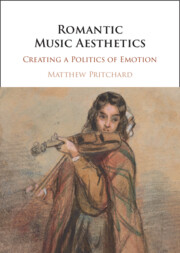Book contents
- Romantic Music Aesthetics
- Romantic Music Aesthetics
- Copyright page
- Contents
- Figures
- Music Examples
- Acknowledgements
- Note on Translation
- Introduction
- 1 Staging Sentimentality
- 2 The Legacy of Rousseau
- 3 The Composer as Genius
- 4 Idealist Aesthetics and the Music Critic
- 5 Picturing the Musical Absolute
- 6 Between Idealism and Realism I: The French Socialists
- 7 Between Idealism and Realism II: After Hegel
- 8 From Hanslick to the Twentieth Century
- Conclusion: The Fate of Feeling
- Bibliography
- Index
1 - Staging Sentimentality
Published online by Cambridge University Press: 22 November 2024
- Romantic Music Aesthetics
- Romantic Music Aesthetics
- Copyright page
- Contents
- Figures
- Music Examples
- Acknowledgements
- Note on Translation
- Introduction
- 1 Staging Sentimentality
- 2 The Legacy of Rousseau
- 3 The Composer as Genius
- 4 Idealist Aesthetics and the Music Critic
- 5 Picturing the Musical Absolute
- 6 Between Idealism and Realism I: The French Socialists
- 7 Between Idealism and Realism II: After Hegel
- 8 From Hanslick to the Twentieth Century
- Conclusion: The Fate of Feeling
- Bibliography
- Index
Summary
The late seventeenth century saw the creation of a new affective category, ‘tender passions’ or ‘sentiments’, by female writers such as Madeleine de Scudéry in the salons of Louis XIV’s France. From here into the eighteenth century, sentiments were developed through airs, novels and drama. Contrary to prevalent images of eighteenth-century communicative clarity, sentiments were more socially complex and less easily legible than the ‘passions’ of the Baroque. Their expression on stage required a new realistic dramaturgy, building on the flexible use of ensemble, gesture and mime in comic opera. A characteristically sentimental conception of the dramatic ‘tableau’ resulted. Theorized by Diderot and Rousseau in the 1750s, tableaux aimed to evoke and sustain ‘tender’ sentiments of pity, affection and social solidarity through dramatically heightened moments in the action. These relied on a more spellbinding theatrical illusion, intended to absorb the audience within its all-engrossing atmosphere, and to which music contributed by supporting and highlighting gestures over rhetorical set pieces.
- Type
- Chapter
- Information
- Romantic Music AestheticsCreating a Politics of Emotion, pp. 26 - 49Publisher: Cambridge University PressPrint publication year: 2024

